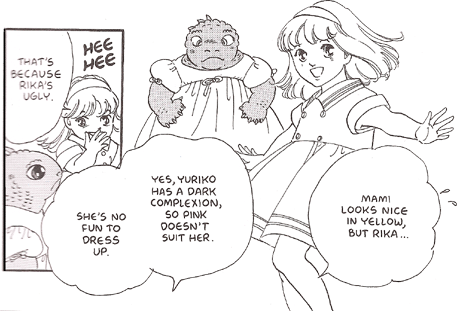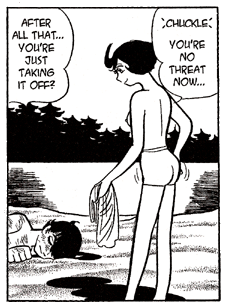

| October 2011 |
|
| Moto Hagio: A Drunken Dream and other stories | |
 Apparently Fantagraphics is publishing manga now, beginning with this upscale volume. It's hardcover and large format, and moreover arranged Japanese style, so you have to read each page and each panel right to left. This isn't one of those sprawling megacomics; it's a set of short stories.
Apparently Fantagraphics is publishing manga now, beginning with this upscale volume. It's hardcover and large format, and moreover arranged Japanese style, so you have to read each page and each panel right to left. This isn't one of those sprawling megacomics; it's a set of short stories.
Hagio is one of the first and most influential creators of shōjo, i.e. comics for girls. So, what are the girls getting? Mostly sad stories about relationships, with a heavy dose of death.
The best of these is called "Iguana Girl", and it's simply amazing. It's about a girl, Rika, who looks like an iguana-- literally; Hagio draws her as an adorable baby lizard. Only no one notices except herself and her mother, who hates her for it.
There's a fantasy element to this-- the story opens with an iguana woman approaching a sorceress, asking to be made into a human girl, as she's fallen in love with a human. But it's also a fable, an acute study of the lifelong effects of a poisonous mother-daughter relationship. The fantasy elements add humor and allow a quick narrative shorthand... e.g. Rika is scared of relationships because she's afraid she'll eat her partners; she eventually finds happiness when she meets a man she thinks of as a bull, thus someone she can't hurt. Finally she comes to terms with her mother in a way that works both at the fantasy and psychological level.
The other stories are not as memorable, though a couple stand out-- one about a pair of Siamese twins, which explores sibling rivalry, and a strange sf story about a pair of people who keep meeting in various lives and kind of fall in love only one of them is always dying.
| Osamu Tezuka : Apollo's Song | |
 This is a fable too; it's a story of a boy, Shogo, who despises love, to the point of psychopathy: he kills animals when they get on his nerves by pairing up. This offends a goddess, who condemns him to fall in love in multiple lives, but to die or watch his lover die before the love can be consummated-- forever.
This is a fable too; it's a story of a boy, Shogo, who despises love, to the point of psychopathy: he kills animals when they get on his nerves by pairing up. This offends a goddess, who condemns him to fall in love in multiple lives, but to die or watch his lover die before the love can be consummated-- forever.
And then Tezuka proceeds to tell this story over and over, in multiple versions: several set in modern times, one set in a German concentration camp, one set in a sf future where humans are replaced by emotionless clones, the Synthians. (The story doesn't go on forever, though; there are just two volumes.)
Tezuka is the grandfather of Japanese manga, with an impressive range, from the kid superhero Astro Boy to a biography of the Buddha to the medical manga Black Jack. He's a fluid storyteller, with a style that easily moves from caricature to realism, and he has a decidedly weird side, which comes out here. It's a little odd to see plots that could easily have appeared in Astro Boy, such as the story of the Synthians, touching on love and sex, with (stylized) nudity.
It's interesting that Tezuka was so popular in Japan, as a running theme of his stories is alienation and rebellion. Shogo is an antihero, and though the goddess has her revenge-- he does fall in love, over and over-- it only turns him from a psychopath to a loner. Black Jack is a renegade surgeon, the Buddha renounced his former life, and even Astro Boy, despite his relentlessly positive outlook, is isolated from human life by his robot nature.
Shogo may have offended the goddess, but what about the girls? What did these girls do to deserve their almost uniformly grim fates? The most interesting of them is Hiromi, pictured at left, who at least has a motivation of her own-- she was a great runner, but was convinced that marathons were "not good for women's bodies" and decides to train Shogo instead.
Tezuka has an unusual way of drawing cute women-- rather sketchy, almost careless, with legs that only barely deviate from the cylindrical. There's something very '60s about the style. These tall, leggy, cute-faced girls survive in plenty of other manga, though they aren't always as spirited as Tezuka's women.
